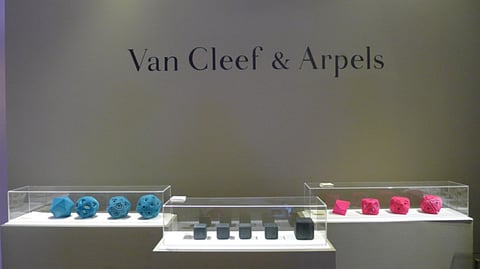Salem Al Mansoori: from product development manager to designer
The winner of Metamorphosis talks about his inspiration, and how his prize-winning trip to Paris has broadened his outlook

Salem Al Mansoori is an engineer and works as a product development manager with etisalat. But in his spare time he uses his computational engineering skills to create innovative designs. The young Emirati designer recently won the Metamorphosis competition, organised by Tashkeel in collaboration with Van Cleef & Arpels and Design Days Dubai. His prize winning project, titled Mimicry, is a series of 3D printed sculptures representing the stages in the metamorphosis of a butterfly. And his prize was a trip to Paris for a week of learning at L’Ecole Van Cleef & Arpels, the company’s school of jewellery design.
The competition, which took place in March, was open to all artists and designers living in the GCC countries, and invited them to submit artworks based on the theme of “metamorphosis”. The theme was inspired by the design philosophy behind Van Cleef & Arpels jewellery pieces such as the Passe-Partout chain-belt which can be worn as a necklace, bracelet or belt and the Zip necklace, which functions like a zipper to transform into a bracelet.
Weekend Review spoke to Al Mansoori about his work and how the trip to Paris has transformed his outlook as a designer. Excerpts:
What was the concept behind this project?
The idea is to represent the life cycle of a butterfly through a series of computer generated 3D geometric shapes. I did a lot of research on different types of butterflies and the four I picked for this project are Small Copper, which is dark grey, the bright pink Swallow Tail, Mazarine Blue and Green Veined Pearl. Using basic platonic shapes such as a tetrahedron, octahedron and dodecahedron to represent the different breeds, I applied progressively complex algorithmic transformation to them.
I then captured each of the shapes in five different stages to tell a story of organic growth similar to the metamorphosis of a butterfly. My designs are inspired by the colours of the butterflies and the emotions they evoked in me, and are an abstraction of the process of transformation they go through. The title Mimicry is borrowed from the scientific term used to describe the phenomenon seen in butterflies of mimicking on their wings the patterns seen on other creatures such as tigers, to protect themselves. And it refers to my geometric imitation of a process in nature.
How did you translate the digital designs into sculptures?
I used the process of 3D printing. The basic forms are made from polyamide and the finishing touches include a velvet-like layer. Each set is different. For instance, “Small Copper” is represented by a simple grey cube, and the changes are expressed subtly through the lines etched along the edges.
But the transformation is much more pronounced in the pink and blue sets, with the opening out of vertices and growing complexity of the lattices on each facet. The last set, inspired by the Green Veined Pearl butterfly, and based on a sphere, has a much more organic feel, and a textured finish. The captions for each set are based on the connections made by Greek philosopher and mathematician Plato between these “platonic” shapes and various elements in nature. And the words try to evoke a sense of zoological classification of the different breeds of the computer generated, geometric creatures on display.
How was your experience at L’Ecole Van Cleef & Arpels?
At the school, which is located in an 18th century mansion in the Place Vendome, I attended lectures and practical workshops on many different subjects related to art and jewellery design. After this intensive week of learning, I have developed a great appreciation for art history and for the design aspect of jewellery making.
Since I do not come from an arts background, I thought there was no need to study about archaic, historical things, but knowing the history of art and design has provided me a context for understanding contemporary design, and helped me to understand that what happens in art is a response to the political, social and cultural environment.
I am now avidly reading about the Renaissance in Europe. I enjoyed working with my hands rather than with a computer and making my own piece of jewellery.
It was also great to meet the other students, who included jewellery, fashion and interior designers, collectors and art and jewellery lovers from around the world.
I also got the opportunity to visit the Museum of Decorative Arts in Paris, which has objects ranging from the classical period to contemporary designs. The entire experience has broadened my vision and given me a good understanding of design across various media.
What are your future plans as a designer?
Winning the competition has boosted my confidence and [provided me with the encouragement] to experiment with new ideas.
I now want to explore new concepts, processes and techniques and I want to work both with the computer and with my hands in the future. And I am certainly very interested in designing a piece of jewellery — especially rings.
Jyoti Kalsi is an arts-enthusiast based in Dubai.
Sign up for the Daily Briefing
Get the latest news and updates straight to your inbox



